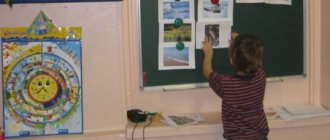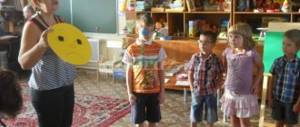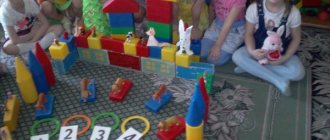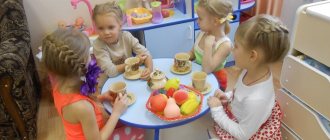- Where to begin?
- For boys
- Reception
Decorating a group room in a preschool institution for each teacher and parents becomes not just a responsibility, but also a creative process. It implements unique ideas and experiences, sometimes from several generations. In this article we will not only describe, but also place various corners in kindergarten in pictures. We hope that our site and this article will be useful to you. Well, let's get started.
Where to begin?
Before you start decorating a group in a kindergarten and creating various thematic corners in a kindergarten, you should definitely take care of the general decoration inside the group . When painting, you should not use a lot of bright colors. It is better if the tone of the main paint is light and “warm”:
- beige,
- peach,
- pearl and so on.
Photo wallpapers with characters from fairy tales and cartoons, as well as stickers with children's themes, look good in children's groups.
It is better to decorate all the group’s rooms in the same style and think in advance about a theme that will tie together the bedroom, reception area, study area and play corners in the kindergarten. Before you start designing specific corners, you should consult with your parents, discuss together and get acquainted with possible options for children of different ages. Here are some corners that can be organized in a kindergarten; for an example, see the photo.
Developmental environment
Play space
Traditionally, each group has a separate room for a bedroom, and the common group room is divided into an activity area and a play area. Play corners for kindergarten are designed differently depending on the age of the children in the group, free space and the creative scope of the organizer. For example, in the play area, a separate place is often allocated for a mummering corner in a kindergarten.
The location for it must be chosen with special care, it must be easily accessible and constantly open to children. The purpose of its design is to create conditions in the group for the creative activity of children, the development of imagination, the formation of gaming skills, the implementation of gaming plans, and the cultivation of friendly relationships between children. You can decorate such a place in the form of a model house, a stylist’s office, or a small screen with a variety of outfits:
- professions,
- animals,
- artists,
- fairy tale heroes and so on.
Once the location has been determined and the design option has been selected, you can begin the practical part. The boundaries of the corner are formed using furniture. This could be: a low rack with shelves, drawers and a crossbar for clothes hangers. For convenience, a table and chairs can be located in the corner. A mandatory attribute in the mummers' corner should be a mirror where children can examine and evaluate their appearance. You can paste pictures of various suits, hats and other items of clothing on the wall.
Design options
Sometimes a hairdresser’s corner in a kindergarten fits harmoniously into such a corner. Here everything is ready to equip the hairdresser’s workplace - a table, a chair for the client, a mirror. On the table you can put bottles, combs, hair decorations, etc. You can glue pictures of scissors and combs on the wall. The apron for the master can be located on one of the hangers on the crossbar.
If space allows, the hairdressing salon corner in the kindergarten is designed separately, as an independent area for the role-playing game “Barbershop”. First, the necessary furniture and shelves are also installed. Instead of a rack with outfits, you can place a bedside table or mini-wardrobe with hairdressing supplies. You can also sew wall pockets for them. Then game items are added. Usually such a place is made as a children's corner for a girl, based on an interest in hairstyles, jewelry, and so on.
Beautiful design of our group
Before jumping directly into the topic of our conversation today, I would like to recommend you some beautiful design ideas that I really like. After all, every teacher wants to make their group not only cozy, but also useful for children and parents. With the help of my recommendations, you will definitely be able to do this.
So, I advise you to pay attention to the following sets (by the way, they are currently at an excellent discount):
- “The daily routine in kindergarten and at home. Screens with information for parents and teachers from 6 sections"
- “Summer: family travel. Screens with information for parents and teachers from 6 sections"
- "The Secret World of Children. Screens with information for parents and teachers from 6 sections"
- Road safety corner "Traffic light"
If you want to streamline your duty schedule, then choose one of the following sets of duty corners for your group. You will see that children will show interest in them, and duty will turn into joy.
- Corner for class attendants (with cards with pictures of fairy tale and cartoon characters)
- Corner for group attendants (with cards for children’s names)
- Corner for class attendants (with cards where children's names are written)
For boys
However, there must be a place for boys to play in the play area. A children's corner for a boy may take up a little more space than for a girl. The main requirements for its location also remain convenience and accessibility for children. Such corners are created to take into account the gaming interests of children of different sexes, their differentiation and the development of gaming activities in general.
Design options are chosen based on the interests of the majority of boys in the group and general “boy” themes. For example:
- car showroom,
- nautical theme (ship),
- workshop,
- military base,
- or a corner of space in kindergarten.
Outer space will be interesting and useful for children of senior preschool age. With its help, children will gain basic knowledge about space, planets, and spaceships in a playful way.
The color scheme of such a corner is determined by the theme.
These are the shades:
- blue,
- purple,
- white and yellow colors.
It would be good if the furniture for the corner was made in the same colors. If the group’s budget does not allow you to buy new furniture, you can use self-adhesive film of the desired color and texture. On the floor you can place a rug with a space theme (lunar surface, meteorite). A simple model of the solar system must be present - either as a poster on the wall, or paper planets in volumetric form, hanging from the ceiling.
Color solution
Individualization in a developing subject-spatial environment in kindergarten
Individualization in a developing subject-spatial environment in kindergarten
In accordance with the Federal Law of December 29, 2012 “On Education in the Russian Federation”, modern preschool education is one level of general education. Rapid changes in society have entailed changes in preschool education; there has been a reorientation from an emphasis on the development of “knowledge, abilities, skills” in preschoolers to the choice of a strategy to support the personal development of each child. Article 64 states “Educational programs of preschool education are aimed at the diversified development of preschool children, taking into account their age and individual characteristics, including the achievement by preschool children of a level of development necessary and sufficient for their successful mastery of educational programs of primary general education, on the basis of individual approach to preschool children and activities specific to preschool children.”
In the general provisions of the Federal State Educational Standard in paragraph 1.4. — the basic principles aimed at developing the individualization of preschool education are revealed:
-building educational activities based on the individual characteristics of each child, in which the child himself becomes active in choosing the content of his education, becomes a subject of education (hereinafter referred to as individualization of preschool education)
-supporting children's initiative in various activities
- age adequacy of preschool education (compliance of conditions, requirements, methods with age and developmental characteristics).
Individualization is the development of characteristics that distinguish a person from the surrounding mass. Individualization is the implementation of the principle of an individual approach, it is the organization of educational activities, taking into account the individual characteristics of pupils, which allows creating optimal conditions for the realization of the potential capabilities of each child.
Individualization is impossible without a specially organized subject-development environment in which the child acts independently. The Federal State Educational Standard for Educational Education makes the following requirements for a developing subject-spatial environment: “A developing subject-spatial environment must be content-rich, transformable, multifunctional, variable, accessible and safe.” RPPS should ensure the possibility of implementing the Program taking into account age and individual capabilities.
In our kindergarten, an internal assessment of the education quality system is carried out, VSOKO includes: monitoring of individual achievements of children, used as a professional tool for the teacher in order to receive feedback from their own pedagogical actions and plan further individual work with children according to the program; 2. monitoring of conditions, which includes: - assessment of psychological and pedagogical conditions; — assessment of the subject-development environment; external public participation, assessment of the quality of implementation of educational programs by parents (legal representatives) of pupils.
In assessing the subject-developmental environment in our preschool educational institution, one of the criteria is individualization.
The names of children in all age groups of our preschool educational institution are written on drawings, booths on chairs; on tables; on the beds. The groups have stands “All about me”, “Hello, I’m here”, “My mood”, “My achievements”. “When I was born”, “My favorite toy”, “Star of the day” (“Star of the week”), “Panorama of good deeds”, “Birthday boy’s corner”, “Palms of success”, “Children say”. There is a box “Business chores” (badges with the child on duty for the day). The information on the stands changes throughout the year. Each group has a designated place for collecting items. Portfolios of children's achievements are maintained.
In order for children to feel emotionally comfortable, in each age group of our kindergarten there are images of families, namely:
— photos, photo albums of each family;
- children's drawings and stories about families;
- things brought by children from home;
— there is a place where children place their things in the group (individual shelves or boxes).
The development of a preschooler’s personality is impossible without the formation in the child of such qualities as confidence and significance. Therefore, in all groups there are photographs of children, portraits, photographs of children engaged in certain activities; information with photographs, achievements.
There are signed children's works (works made on a theme, or spontaneous children's creativity). Educators place children's creative products in both reception and group rooms. Children can independently place their drawings and crafts in specially designated areas. Teachers create individual exhibitions (placed both in the reception area and in the halls of the kindergarten).
One of the main conditions for creating individualization in the RPPS is the active participation of parents. Parents in our kindergarten are our social partners, participants in the educational process in the preschool educational institution. Parents help in creating children's portfolios, help in organizing individual exhibitions, and participate in the creation of family and children's projects. In addition, parents share information about their child and their experience in raising them. Parents also take part in monitoring the child’s individual achievements.
Properly thought out and constructed individualization in a developing subject-spatial environment provides the preschooler with opportunities for self-development and independence, the development of cognitive activity and initiative, and helps to raise a confident, creative personality.
Gultyaeva Irina Aleksandrovna,
senior teacher of MKDOU d/s No. 451
Reception
The locker room or reception area is the first thing a child and his parents see when they bring their child to kindergarten. Therefore, its design must be taken seriously. For children, there is usually a mood corner in kindergarten. The purpose of such a corner is to create a favorable emotional environment in the group. Thanks to it, children learn to understand not only their own mood, but also the mood of their peers.
In the design of such a corner, ready-made stands or home-made models can be used. The principle of their design is the same: in several pockets there are pictures with different emotions (their number depends on the age of the children), pockets for photographs of children are attached to the bottom. Coming to the group, the child, together with a parent or teacher, determines his mood and places his photo in the pocket under the corresponding emotion.
If the mood changes during the day, the photo is rearranged. Emotions can be depicted in the form of emoticons and cartoon characters. An approximate list in the older group could be: joy, fun, calm, surprise, sadness, anger.
note
It’s worth paying attention to the corner of the menu in kindergarten. The purpose of its creation is to familiarize parents with the child’s diet outside the home, as well as the basic principles of nutrition for preschool children. We can decorate it as a ready-made stand or manually (with painted pictures on the theme of the group, in the form of three-dimensional figures made of salt dough). Usually it has several pocket compartments. They contain a daily menu, as well as rules for feeding children.
Find out how to make a children's playground out of logs with your own hands in our material! You will learn how to properly make clothes for children in our article!
At https://karuselkin.ru/sad-i-shkola/kak-organizovat-i-provesti-detskij-novogodnij-utrennik/ link you will find interesting scenarios for the New Year.
If entering kindergarten is not an urgent problem, and you are just preparing to become parents, then you can beautifully decorate the room for your child by organizing children's corners for newborns. Usually they provide a sleeping place for the baby, a changing place and a place for clothes and toys. The colors of furniture and wallpaper should also be chosen soothing and light. You can paste a few funny pictures of children's toys. Soft toys are excluded in such a corner. So, the options for children's corners can be varied, the main thing is that they are aesthetically designed, safe and interesting for children.
Individualization of educational activities in preschool organizations
We often think about what our student should be like. We want the child to be healthy, friendly and responsive, independent, proactive, inquisitive, confident in his abilities, and able to set goals for himself. If we compare these qualities with the portrait of a preschool graduate in the context of the Federal State Educational Standard, we will see obvious coincidences.
Traditionally, the teacher was obliged to give the child knowledge in accordance with program requirements. Life changes quickly and neither a teacher nor a parent can predict what knowledge a child will need in the future. Hence the need arises to develop the child’s ability to learn and develop throughout his life. This can be done through the individualization of education, which allows taking into account the interests, capabilities and social situation of the development of pupils of a preschool educational organization.
Practice shows that there cannot be two children who learn and develop in exactly the same way - each child acquires and demonstrates his own knowledge, attitude, skills, personality traits, etc. All children, including typically developing children, have individual characteristics that I identify and take into account to ensure that the learning and development process is optimized. By carefully observing students and identifying their interests and strengths, I help children solve problems in ways that suit their individual learning styles. Thus, the individualization of education is based on supporting children in the development of potential capabilities, stimulating the desire of children to independently set goals and achieve them in the process of cognition. My focus is on ensuring that every child actively participates in educational activities.
The traditional approach, which assumes that all children react equally to a certain teaching method, that one should be “like everyone else,” “not show character,” “don’t demand too much,” often turns out to be ineffective in teaching. When working with children, you can hear the following phrase: “Look how Seryozha draws, he does it wrong, not like everyone else.” In this case, I respond positively to the child’s individual characteristics, while demonstrating to the children that accepting others and responding to differences is important and correct. It should be noted that there must be mutual respect between the teacher and the children. Respect is a necessary element in every community. Children, noticing how I show respect for each child in the group, learn to accept all other children - and those who run slowly; and those who draw well; and even children with unusual or challenging behavior. After all, the degree of respect that children feel from other people is a key factor in the development of their self-esteem, which, in turn, lays a strong foundation for positive relationships with other children.
Individualized learning occurs simultaneously on multiple levels. In its broadest sense, individualization can extend to an entire group of children. The group is a unique micro-society with its own unique subculture (favorite activities and games, rules accepted in the group, interests of children, characteristics of interpersonal communication and other characteristics), in which the individualization of learning and development manifests itself spontaneously. Making their own choice of content, partnership, materials, place and method of work, each child acts at his own discretion or in agreement with other members of the microgroup at his own pace, obtaining his own results, including acquiring new knowledge and skills. This is clearly visible when children are offered games of various content. One child chooses the game “Collect a picture”, three or four pupils team up for the game “Mosaic”. It happens that out of the entire group of children, one child will pick up a book and look at it with great interest.
In order for natural individualization to take place, I promptly organize a developmental environment that stimulates the activity of children. If a child experiences any difficulties during independent games, for example, in the game “Build a Pyramid,” I come to the rescue. The child himself feels that something did not work out for him. I encourage, ask questions that lead the child to think. Thus, the student finds a way out of the current situation.
To implement individualization during planning, I determine the elements to ensure it: flexibility in the implementation of activities and careful selection of materials. For example, during sculpting, children plan to sculpt animals. I organize activities in such a way that children have the opportunity to choose: what animal each of them will sculpt; from what material (plasticine of different colors, colored dough, clay, paper pulp). My task is to help those who find it difficult to start work on their own. I help some with words, I encourage others, and I provide physical help to others if they need it. More capable students can make many different animals, as complex as they wish. Next, I can offer my assistance in designing a complete composition. During my work, I ask questions of different directions and complexity, offer different options for performing actions and ideas. Instead of directly telling children what and how they should do, I help them do what the students themselves want. This approach provides a relationship structure through which children can maintain independence and I can respond to their individual wants and needs when necessary. The example of sculpting also illustrates another element of individualization—the careful selection of materials. Most of the materials I use are flexible and have varying degrees of complexity - from the simplest to the most complex. This variability creates optimal opportunities for individualizing education, since the use of materials involves natural individualization.
Individualization can be observed at the subgroup level within one group of children. Any activity independently chosen by the children or organized by the teacher can be performed in small subgroups of four to five children. When the children make a choice, break into small subgroups and independently do what they have chosen, I watch them carefully. During the activities of the pupils, I devote some time to each small subgroup or individual children, providing them with support and assistance if necessary.
Traditionally, the process of education and upbringing was mainly focused on the average level of development of the child, so not every student could fully realize their potential. Today, one of the solutions to this problem is the preparation and implementation of an individual educational route, which helps to reveal the personal potential of the student. When drawing up and implementing an individual educational route, I use both traditional and modern methods and techniques. Through conversations, games, activities, reading fiction, sketches, I introduce various emotions and feelings. I conduct games, exercises and trainings that promote the development of emotional, personal and behavioral spheres (developing communication skills and improving relationships with others, relieving fears and increasing self-confidence, reducing aggression and weakening negative emotions): “Mirilki”, “Morning of joyful meetings” , “Let's smile at each other”, “We'll hold hands” and others. To develop mental processes, I include in an individual educational route such games and exercises as “Cabinets”, “What has disappeared?”, “What has changed?”, “Say it in one word”, “Find the differences”, “Complete the drawing”, “What did you sound? " To effectively implement an individual educational route, I constantly study and identify the level of development of each child, the pace of his progress, look for the reasons for the lag, outline and solve specific tasks that would ensure further development.
Practice has shown that the use of individualization of education maximizes the individual potential of the child, and also qualitatively affects the positive attitude of children to the learning process, increasing the level of performance in the classroom, and the depth and quality of assimilation of program material by each child and the group as a whole. When planning and organizing any activity, the teacher must not forget that the child is the subject of his own development. A modern teacher must work “from the child”, creating conditions for his successful socialization, development of personality and individuality.
Literature
- Vershinina, N.B., Modern approaches to planning educational work in kindergarten. Reference and methodological materials [Text] / N.B. Vershinina, T.I. Sukhanov. -Volgograd: Teacher, 2010. - 111 p.
- Kovalchuk, L.I. Individual approach to raising a child: A manual for kindergarten teachers [Text] / L.I. Kovalchuk.-2nd ed., add. – M.: Education, 1985. – 112 p.
- Lesina, S.V. Individual development of children in preschool educational institutions. Diagnostics, planning, lesson notes [Text] / S.V. Lesina.–2nd ed., stereotypical. – Volgograd: Teacher, 2008. – 237 p.





